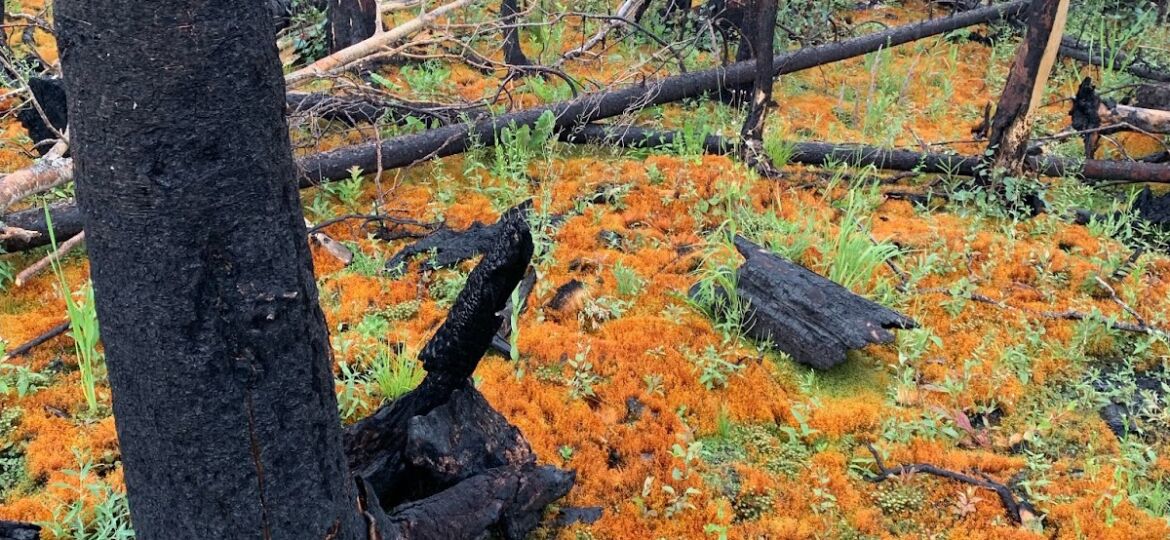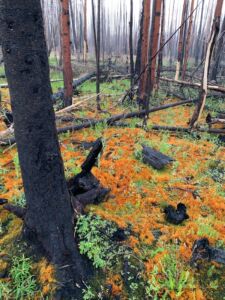
From the Ashes: Impacts of Wildfires in Colorado
A look into how wildfires in Colorado continue to impact the ecosystem.

Less than two years after the biggest fire in Colorado history, wildflowers can be seen blooming between the charred, blackened trunks of needleless pines lining mountainsides like matchsticks. The 2020 Cameron Peak fire in Northern Colorado burned 208,913 acres and 469 structures, according to the Incident Information System, costing $133 million in damages. This fire demonstrates the increasing severity of fires in the state and the immensity of the destruction it can cause. Though, the regrowth of vegetation also portrays the positive impacts that fires can have on the soil, plant species and overall ecological health of forest environments. Wildfires are worsening because of climate change and often have negative impacts on infrastructure, recreation, finances and human health but they are also essential regenerative forces for ecosystems.
The 20 largest wildfires have taken place in the past 20 years, according to The Division of Fire Prevention and Control, and these fires are getting more destructive over time. Just last year, the Marshall fire “destroyed and damaged more than 1,000 homes and over 30 commercial structures,” according to Boulder County’s website, making it the most structurally destructive fire in Colorado history. Beyond the loss of structures, the damage and debris left in the wake of the fire will take millions of dollars to clean and repair and many years to do so. This not only affects the daily lives of Colorado residents in these areas, but also the economies of these cities and Colorado as a whole.
The burned areas also constitute a significant economic cost to Colorado. Some trees that burned in fires could have potentially been sold and used as lumber, but are no longer a viable natural resource to be profited from.
In addition, fires “take away huge amounts of trails that would drive tax dollars for recreation funds,” said Sean McLennan, a fourth year Forest Management student, vice president of the Colorado State University forestry Honor Society and a member of the Students Association for Fire Ecology.
Forest fires also have a significant impact on human health due the increase of smoke that affects air quality. According to a study published by The National Library of Medicine, “An estimated 26% of summertime organic aerosols in the western US come from wildfires; this fraction is expected to increase as wildfires become more prevalent.” The study goes on to highlight the health impacts of wildfire smoke, especially the exacerbation of preexisting conditions such as asthma and chronic obstructive pulmonary disease (COPD). The National Library of Medicine also estimates the current United States health costs of wildfire smoke to be $11-20 billion a year. Wildfires also greatly impact water quality in many areas surrounding the burn by polluting water sources with ash and other debris.
Climate change is a contributing factor increasing the number and severity of fires across Colorado and beyond. Global warming is causing an extension of the warm season, decrease in snow pack and changing weather cycles, including wind and rain patterns according to a Proceedings of the National Academy of Sciences (PNAS) journal of the National Academy of Sciences. These factors all contribute to a longer and more intense fire season.
“If you look in the past decade, the amount of fires that have gone up across the nation has been almost exponential,” said McLennan. “One can tie that to climate change, but there are a lot of other correlations that affect it too.” Other factors that have contributed to an environment more susceptible to wildfires include historical fire suppression and an increasing population of insects such as pine beetles. These insects kill pine trees in dense forests, creating dead stands of trees that have no resistance in the case of a large fire.
“Climate change seems to just be dumping fuel on the fire, but I think that with proper management, there could be a brace against the effects of climate change in Colorado,” said McLennan. Prescribed burns are one way to manage the increasing risk of forest fires by periodically clearing the dense understory of forests. These controlled fires decrease the amount of fuel available in the forest, therefore making it harder for unexpected wildfires to spread. These prescribed burns “can just take out small trees and leave larger ones, so that development can happen and there can be new refreshment in the soil,” said McLennan.
This returning of nutrients to the soil through the ashes of burned organic material plays an important ecological role in the aftermath of forest fires. Throughout history, fires have periodically cleared forests and recycled nutrients as a naturally occurring process in a healthy forest environment. But, for many decades humans have been suppressing fires around civilizations and built structures in order to protect establishments and the lives of people. This has not only degraded the health and stagnated the growth of the environment, but has also increased the risk for larger and more intense fires.
Another way fires are beneficial for forest ecosystems is because many tree and other plant species require fires to open their seeds. The seeds have evolved to have a waxy coating on the outside that melts in a fire, exposing the seed and allowing it to take advantage of the burn
area, where there is more nutrients in the soil and less competition from older, more established plants. This promotes regrowth of species and recovery of a forest ecosystem.
McLennan did field work in a burn scar during the summer of 2022, collecting data about the understory recovery from the Cameron Peak fire. During this experience, McLennan witnessed firsthand the initial regrowth of this ecosystem. His time spent in these burn scars gave him hope “that there would still be growth and adapted species that are designed to recover from fire even after such an extended, unnaturally large occurrence that happened that year.”
Forest fires are increasing in severity and have become larger in recent years due to a variety of factors. Climate change is creating a warmer and dryer global environment, which is therefore more susceptible to fires. The trend of fire suppression to protect modern establishments has also caused an overgrowth of forest environments and has left more fuel in forested areas which can create fires that burn hotter and more intensely. Humans often feel the negative impacts of these fires, relating to health issues, infrastructural damages and economic impacts. But, what is not often highlighted is how essential these fires are to the health of the ecosystem and toward preventing future fires from being even more destructive.

